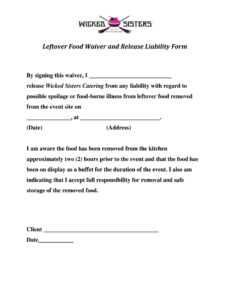Utilizing such documentation offers several advantages. Clear communication about ingredients and potential risks fosters trust and transparency between food providers and consumers. These documents can help protect providers from liability in case of allergic reactions or other adverse events related to disclosed risks. Moreover, they empower consumers to make informed decisions about what they eat, fostering a safer and more responsible food sharing environment.
The subsequent sections delve into the specific components, best practices, and legal considerations related to creating and implementing these vital documents. Understanding these aspects is essential for anyone involved in providing food to others outside of traditional retail environments.

Key Components of Food Risk Management Documents
Effective documents addressing food-related risks require specific components to ensure clarity and legal soundness. These components work together to inform consumers and protect providers.
1: Identification of the Food Provider: Clearly stating the name and contact information of the individual or entity providing the food establishes responsibility and allows for direct communication if needed.
2: Detailed Ingredient List: A comprehensive list of all ingredients, including potential allergens, is paramount. This allows individuals with allergies or sensitivities to make informed choices.
3: Allergen Information: Explicitly highlighting common allergens like nuts, dairy, gluten, soy, and shellfish helps consumers quickly identify potential risks.
4: Disclaimer for Homemade or Non-Commercially Prepared Foods: If the food is prepared in a non-commercial setting, a disclaimer stating that it is not subject to the same regulations as commercially produced food is often necessary.
5: Waiver Regarding Dietary Restrictions: A statement acknowledging that while reasonable efforts are made to accommodate dietary restrictions, cross-contamination or unintentional errors are possible can limit liability.
6: Assumption of Risk Statement: This section clarifies that the consumer understands the potential risks associated with consuming the food and assumes responsibility for their decision to eat it.
7: Signature Lines: Including spaces for both the food provider and the consumer to sign and date the document creates a record of agreement and understanding.
These elements ensure that consumers receive crucial information about potential food-related risks, allowing them to make informed choices. Simultaneously, these components protect providers by clarifying responsibilities and limiting potential liability.
How to Create a Food Risk Management Document
Creating a comprehensive document for managing food-related risks involves several key steps. Careful attention to these steps ensures clarity, manages expectations, and provides important legal protections.
1: Consult Legal Counsel: Seeking professional legal advice is recommended to ensure the document complies with all applicable local regulations and adequately addresses potential liabilities.
2: Identify the Food Provider: Clearly state the name, contact information, and any relevant business details of the entity or individual providing the food.
3: Develop a Detailed Ingredient List: List all ingredients, including any additives or preservatives. Highlight common allergens (e.g., nuts, dairy, gluten, soy, shellfish) prominently.
4: Include a Disclaimer for Non-Commercial Preparation (If Applicable): If the food is prepared outside a commercial kitchen, state that it is not subject to the same regulations as commercially prepared food.
5: Craft a Waiver Regarding Dietary Accommodations: Acknowledge that while reasonable efforts are made to accommodate dietary restrictions, cross-contamination or unintentional errors are possible.
6: Incorporate an Assumption of Risk Statement: Clearly state that consumers understand the potential risks and assume responsibility for their consumption choices.
7: Designate Signature Lines: Include spaces for both the food provider and the consumer to sign and date the document, creating a record of agreement and understanding.
8: Make the Document Accessible: Provide the document in a clear and accessible format, ensuring readability and ease of understanding for all parties.
A well-drafted document fosters transparency and manages expectations, ultimately contributing to a safer and more responsible food-sharing environment. These steps help establish a clear understanding between food providers and consumers, contributing to a safer and more informed food experience.
Careful consideration of liability and consumer safety is paramount when providing food, especially outside of established commercial settings. Documents addressing potential risks, including allergen disclosures, disclaimers for homemade goods, and waivers regarding specific dietary needs, provide crucial protection for both consumers and providers. These documents establish clear communication, manage expectations, and offer a framework for informed decision-making regarding food consumption. Understanding the essential components and proper implementation of these documents is vital for fostering a responsible and safe food-sharing environment.
Proactive risk management through comprehensive documentation is not merely a legal safeguard but a demonstration of respect for consumer well-being. Prioritizing transparency and open communication about food-related risks builds trust and fosters a more responsible and informed approach to food preparation and consumption. This proactive approach strengthens the overall food-sharing experience, promoting safety and peace of mind for all involved.



